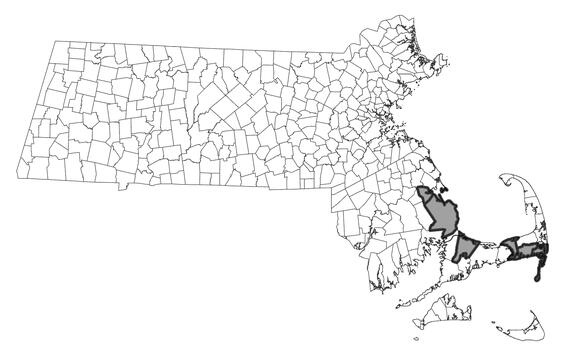- Scientific name: Eupatorium novae-angliae
- Species of Greatest Conservation Need (MA State Wildlife Action Plan)
- Endangered (MA Endangered Species Act)
Description
New England boneset (Eupatorium novae-angliae) is a globally rare, New England endemic of the composite family (Asteraceae). A perennial herb of coastal plain pondshores, it has opposite leaves and heads of small, white flowers.
New England boneset is a tall plant, up to about 1 m (3.3 ft) in height. The leaves are opposite, sessile, tapered to the base, sharply toothed, and hairy (pubescent); they are 3-8 cm (1.1-3.1 in) long and 0.8-2.3 cm (0.3-0.8 in) wide. The inflorescence is a corymb of discoid heads, each made up of five to seven (nine) white flowers, which bloom in late summer, from August to September. The leafy bracts subtending the heads (phyllaries) are long-tapered (acuminate) and prominently whitish at the tip.
New England boneset can be confused with other bonesets that have sessile or nearly sessile leaves in Massachusetts, and a technical key should be consulted to confirm identification. Similar species include rough boneset (E. pilosum), tall boneset (E. altissimum), and upland boneset (E. sessilifolium), none of which have long-acuminate phyllaries. Another species, boneset (E. perfoliatum), has perfoliate leaves, opposite leaves that are fused and perforated by the stem.
Life cycle and behavior
This is a perennial herb.
Population status
New England boneset is listed under the Massachusetts Endangered Species Act as endangered. All listed species are legally protected from killing, collection, possession, or sale, and from activities that would destroy habitat and thus directly or indirectly cause mortality or disrupt critical behaviors. The MassWildlife’s Natural Heritage & Endangered Species Program has 15 records from 2 counties: Barnstable and Plymouth. Ten of these records have been observed within the last 25 years.

Distribution in Massachusetts. 1999-2024. Based on records in the Natural Heritage Database.
Distribution and abundance
New England boneset is endemic to the coastal plain of southern New England, known from only two counties in Massachusetts and two in Rhode Island.
Habitat
In Massachusetts, New England boneset inhabits sandy to peaty, nutrient-poor soils of the upper, dryer margins of coastal plain pondshores, in full or partial sun. Associated species include golden hedge-hyssop (Gratiola aurea), pond-shore rush (Juncus pelocarpus), grass-leaf goldenrod (Euthamia graminifolia), toothed flatsedge (Cyperus dentatus), and rose coreopsis (Coreopsis rosea). Several rare species can be associated with New England boneset, including Plymouth gentian (Sabatia kennedyana, special concern), terete arrowhead (Sagittaria teres, special concern), Torrey’s beak-sedge (Rhynchospora torreyana, endangered), and Wright’s panic-grass (Dichanthelium wrightianum, special concern).
Healthy habitats are vital for supporting native wildlife and plants. Explore habitats and learn about conservation and restoration in Massachusetts.
Threats
New England boneset is threatened by any activity that changes the hydrologic regime, water, quality, or soil integrity of the coastal plain pond they inhabit. Region-wide, coastal plain ponds are imperiled due to shoreline development, water table drawdown (from wells), eutrophication (resulting from fertilizers and septic systems), and soil disturbance from heavy recreational use (Off Road Vehicle, horse, and foot traffic; camping; boat-launching; raking and digging).
Conservation
Management of New England boneset requires protection of the hydrology, water quality, and soil integrity of its habitat. Like many other coastal plain pondshore plant species, New England boneset requires pronounced water-level fluctuations, acidic, nutrient-poor water and substrate, and an open, exposed shoreline, free from major soil disturbance. The hydrologic regime is particularly important; coastal plain pondshore species often require low water years for reproduction, but their persistence at a site depends on high water years to keep dense woody vegetation from taking over the shoreline.
Protection of New England boneset habitat may require exclusion of new wells and septic systems, prohibitions on fertilizer use, and restrictions on recreational use of the coastal plain pondshore. Recreational activities such as swimming, hiking, and horseback riding should be diverted from the plant population location by re-routing trails, installing fences, and providing alternative locations for the activities.
Sites that appear to have encroaching woody vegetation could be carefully thinned after the growing season (November–April). The nature of coastal plain ponds makes them generally inhospitable for many exotic invasive plants, but invasives could become established at sites that have received heavy soil disturbance or nutrient inputs.
Populations should be monitored to identify threats such as over-shading, invasive plant establishment, and soil disturbance. New England boneset is most likely to be observed in late summer during low water years. To avoid inadvertent harm to rare plants, all active management of rare plant populations should be planned in consultation with MassWildlife’s Natural Heritage & Endangered Species Program.
Contact
| Date published: | May 7, 2025 |
|---|